#bamboo and clay sculpture
Explore tagged Tumblr posts
Text



Lũn͇k̔y̩ aņ̣͡ḓ̵ Fͮ̈́r̪i͌ē̫ͪn̈́ͨ͡d̊̊͗s!̯̮
Started: April 6, 2023
Finished: April 9, 2023
Anyone who knows me knows that I get pretty much all of my entertainment from YouTube. Some of my favorite content-creators include MatPat, CoryxKenshin, Rosanna Pansino, Nathan Sharp, James and his crew on Dead Meat...and, of course, the one and only Markiplier.
While Lunky was both funny and creepy to watch when he first appeared, I didn't really get inspiration from him.
No spoilers in case you haven't seen certain videos, but once Lunky came back with his new design, I got more intrigued. And then, when his friends were introduced as part of an ambush on Mark...
I usually have a hard time keeping my sculptures small, but these ones came out relatively palm-sized.
I actually managed to include Lunky's "stitches" by cutting up bamboo skewers, painting them black, and pushing them in-between his halves before the clay started drying. (Yeah, I know it's hard to see them with how I took the picture. Sorry about that 😅)
@sammys-magical-au @inkbedou @mostlyghostly42
#art#sculpture#pottery#clay#ceramics#painting#acrylic paint#my projects#my art#weird art#horror art#markiplier#mark fischbach#markiplier lore#lixian#lixiantv#luis costa#marc schneider#editor marcus#nerdfiction#rachel shatto#editor rachel#rad_R#markiplier lunky#lunky#lunky's friends#tw body horror
37 notes
·
View notes
Text
A walk through Bengal's architecture
Bengali architecture has a long and rich history, fusing indigenous elements from the Indian subcontinent with influences from other areas of the world. Present-day Bengal architecture includes the nation of Bangladesh as well as the Indian states of West Bengal, Tripura, and Assam's Barak Valley. West Bengal’s architecture is an amalgamation of ancient urban architecture, religious architecture, rural vernacular architecture, colonial townhouses and country houses, and modern urban styles. Bengal architecture is the architecture of Wind, Water, and Clay. The Pala Empire (750–1120), which was founded in Bengal and was the final Buddhist imperial force on the Indian subcontinent, saw the apex of ancient Bengali architecture. The majority of donations went to Buddhist stupas, temples, and viharas. Southeast Asian and Tibetan architecture was influenced by Pala architecture. The Grand Vihara of Somapura, which is now a UNESCO World Heritage Site, was the most well-known structure erected by the Pala rulers.

The Grand Vihara of Somapura
According to historians, the builders of Angkor Wat in Cambodia may have taken inspiration from Somapura. Bengal architecture became known for its use of terracotta due to the scarcity of stone in the area. Clay from the Bengal Delta was used to make bricks.
The temple architecture has distinct features like the rich wall decoration, often known as the terracotta temples, which was one of the remarkable elements of Bengali temple architecture. The double-roofed architecture of thatched huts was replicated by Bengali temples. Square platforms were used to construct the temples. Burnt brick panels with figures in geometric patterns or substantial sculptural compositions served as the temples' adornment.

Dochala style
These served as models for many temples that were built in undivided Bengal. Construction materials used in ancient times included wood and bamboo. Bengal has alluvial soil, so there isn't a lot of stone there. The bricks that were utilized to build the architectural components were made from stone, wood, black salt, and granite. Bengal has two different types of temples: the Rekha type, which is smooth or ridged curvilinear, and the Bhadra form, which has horizontal tiers that gradually get smaller and is made up of the amalaka sila. Mughal architecture, including forts, havelis, gardens, caravanserais, hammams, and fountains, spread throughout the area during the Mughal era in Bengal. Mosques built by the Mughals in Bengal also took on a distinctive regional look. The two major centers of Mughal architecture were Dhaka and Murshidabad. The do-chala roof custom from North India was imitated by the Mughals.

Jorasako thakurbari
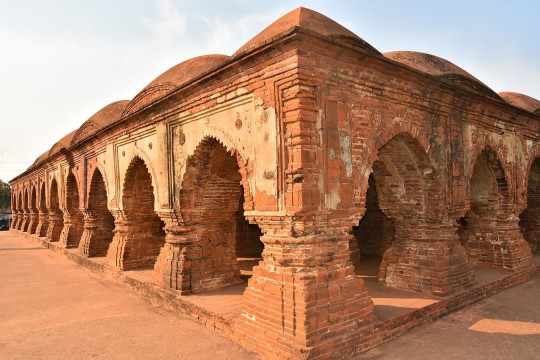
The Rasmancha is a heritage building located at Bishnupur, Bankura district, West Bengal.
Influence of the world on Bengal architecture: Although the Indo-Saracenic architectural style predominated in the area, Neo-Classical buildings from Europe were also present, particularly in or close to trading centers. While the majority of country estates had a stately country house, Calcutta, Dacca, Panam, and Chittagong all had extensive 19th and early 20th-century urban architecture that was equivalent to that of London, Sydney, or other British Empire towns. Calcutta experienced the onset of art deco in the 1930s. Indo-Saracenic architecture can be seen in Ahsan Manzil and Curzon Hall in Dhaka, Chittagong Court Building in Chittagong, and Hazarduari Palace in Murshidabad.
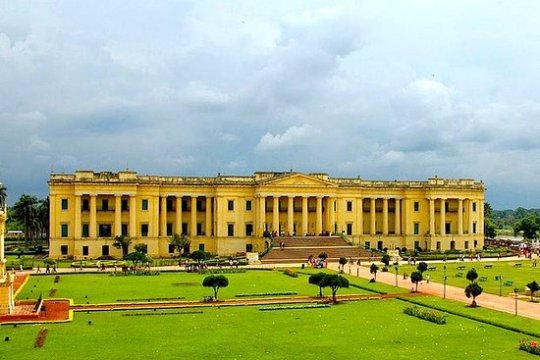
Hazarduari Palace in Murshidabad
The Victoria Memorial in Kolkata, designed by Vincent Esch also has Indo-Saracenic features, possibly inspired by the Taj Mahal. Additionally, Kolkata's bungalows, which are being demolished to make way for high-rise structures, have elements of art deco. The 1950s in Chittagong saw a continuation of Art Deco influences. The Bengali modernist movement, spearheaded by Muzharul Islam, was centered in East Pakistan. In the 1960s, many well-known international architects, such as Louis Kahn, Richard Neutra, Stanley Tigerman, Paul Rudolph, Robert Boughey, and Konstantinos Doxiadis, worked in the area.

The Jatiyo Sangshad Bhaban
This iconic piece of contemporary Bangladeshi architecture, was created by Louis Kahn. Midsized skyscrapers dominate the cityscapes of contemporary Bengali cities, which are frequently referred to as "concrete jungles." With well-known architects like Rafiq Azam, architecture services play a key role in the urban economies of the area. Overall Bengal architecture was influenced by various contemporaries of their time and continues to evolve.

Gothic architectural style seen in St. Paul's Cathedral in Kolkata.

Zamindar era buildings in ruin.

Belur Math in Howrah
#bengali#bangla#west bengal#bangladesh#tripura#assam#desi#বাংলা#india#architecture#tales#bengal architecture#history#kolkata#international#technology#information#temple#asia#bricks
193 notes
·
View notes
Text




June 5th, 2024 (hike #11, 3-4 mi)
Walked through the Xitou Forest Education Area today. It was super rainy and humid. Like the rest of the hiking in Taiwan, there were lots of steep uphills and lots of stairs.
The forest was gorgeous. Many of the trees are very old, with the oldest being a tree that was 2,800 years old before it was struck by lightning and fell in 2016. It was huge!
The bridge was built during the Japanese colonial period and it’s made completely from bamboo!
The Xitou Forest is located right next to the Monster Village. It had an old Japanese vibe with cute shops and monster sculptures.



After our hike we got clay pot chicken and noodles in chicken oil. It was one of the best meals I’ve had here. The chickens they use were roaming free right outside of the restaurant. The matcha/charcoal soft serve was good, too.
16 notes
·
View notes
Text
I took a captivating trip to the Nkyinkyim museum in Ada, just a 2-hour drive from Accra. The tour, priced at 100gh per person, was hosted by a griot, a very enthusiastic storyteller whose energy transformed the tour into an exciting journey.

The tour commenced with artifacts at the entrance, revealing the wonders of Sudano-Sahelian architecture dating back to 2500BC. The structures, crafted from organic materials like red mud, clay, and bamboo, showcased the remarkable skill and eco-friendly ingenuity of our ancestors. The community engagement in the construction process mirrored their deep connection with nature.

Intrigued by the symbolism etched on the walls, I marveled at the adinkra symbols, patterns, and shapes that were not only aesthetically pleasing, but held profound meanings. The journey unraveled the cultural ties across Africa, even discovering that Sudan boasts more ancient pyramids than Egypt.
The griot animatedly shared the wisdom behind the symbols—footprints symbolizing our shared humanity, the spider embodying intelligence, the tortoise exemplifying adaptability, and the snail conveying the concept of leaving a lasting legacy. The ant emerged as a powerful symbol of collaboration and community, echoed by the Nkyinkyim symbol representing resilience inspired by nature.
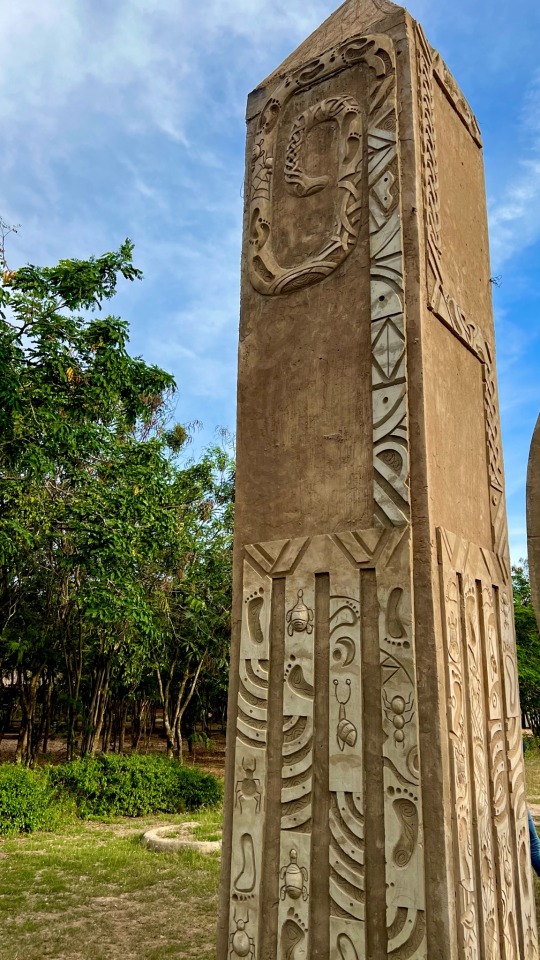
There was also a structure that was described as a life sized Lukasa memory board which challenged the notion that African traditions were solely oral. It became clear that our history was archived through symbols, writings, and memory boards, providing a unique form of communication despite the challenges faced during colonial times.
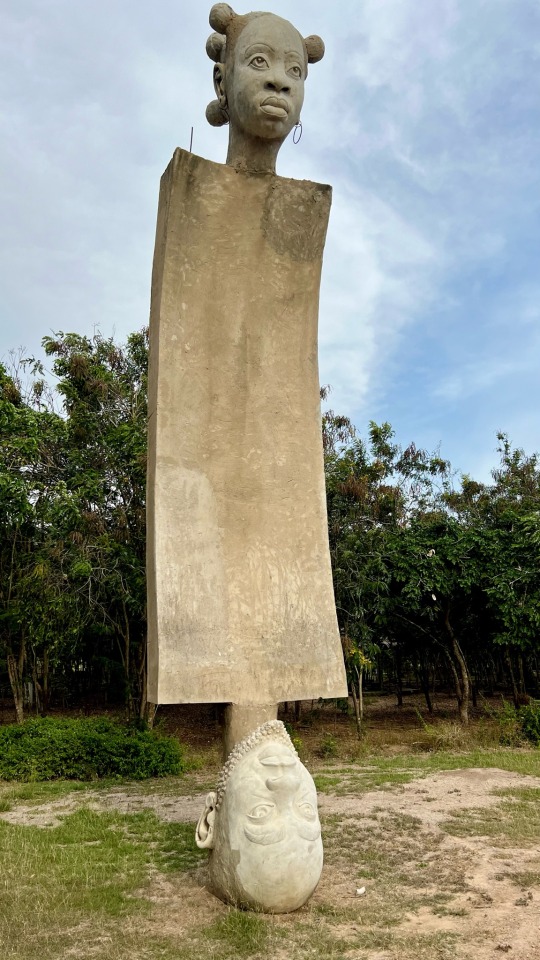
The journey progressed to a wall adorned with discs inspired by the Dikenga cross, a core symbol of Bakongo religion of the Kongo people symbolizing the cardinal points of human existence and the cycle of life.
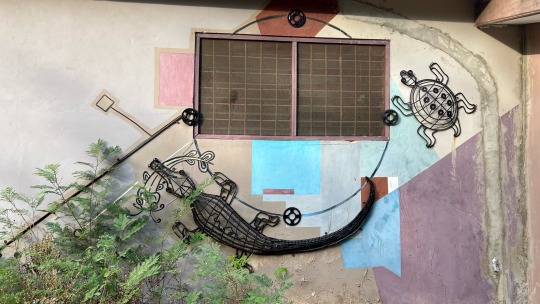
The emotional apex was the veneration site—a symbolic memorial to enslaved ancestors. Sculptures conveyed tales of capture, from shock and determination to hidden identities and interrupted hair appointments. The vivid facial expressions on the sculptures offered a poignant glimpse into their harrowing experiences and the traumatizing ways through which they were captured.
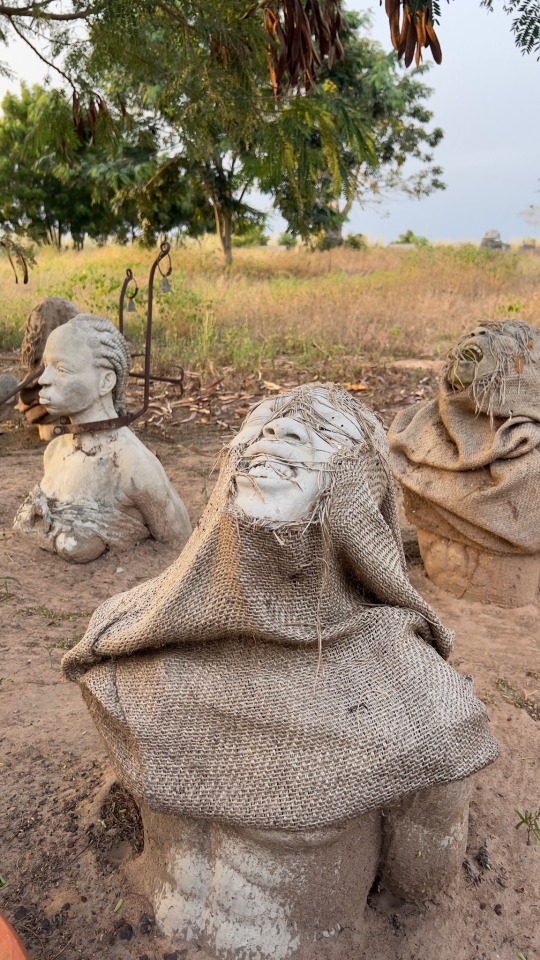

There was a wall featuring diverse writings from across the continent, such as Nsibidi and vèvè, underscoring the richness of African history. The trip left me inspired to delve deeper into our heritage, resonating with the concept of Sankofa: going back to our ancestors' ways to chart a purposeful future.
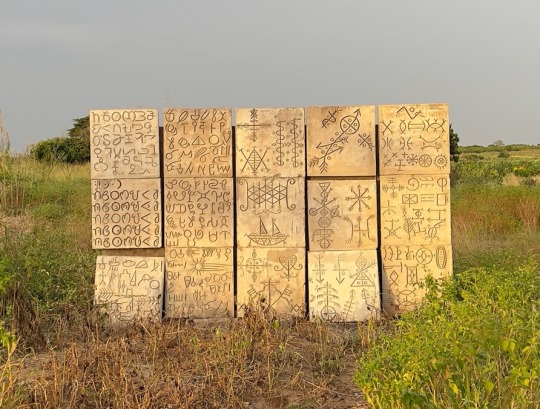
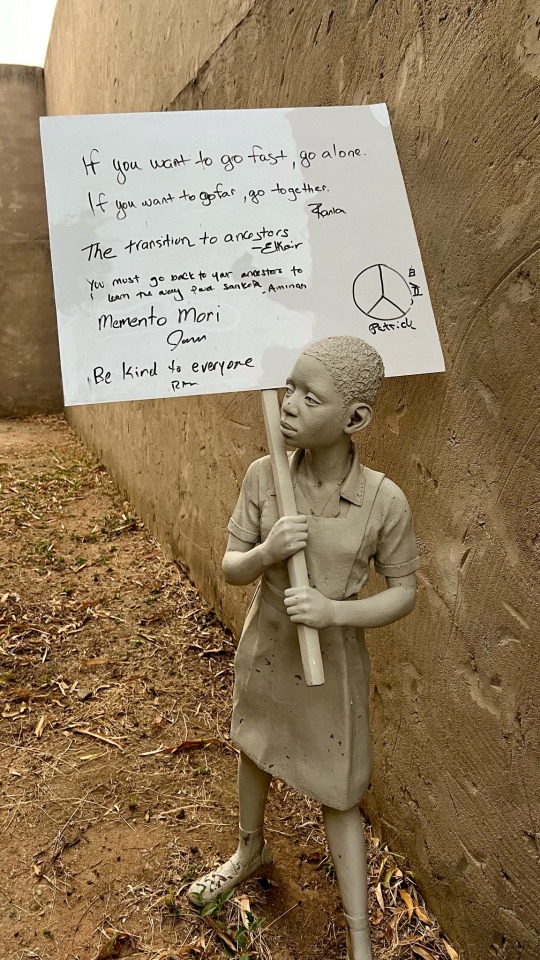
The final chapter featured paintings showcasing accomplished individuals of African descent, a testament to resilience and exceptional lives emerging from the shadows of history. This transformative experience reinforced the belief that understanding our roots definitely shapes the trajectory of our future endeavors.
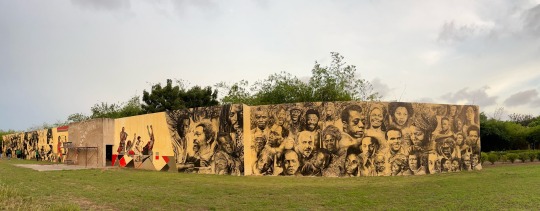
11 notes
·
View notes
Text

Like an ancient tree etched into clay, this vase stands tall and grounded, its surface wrapped in the delicate branches of a ginkgo tree (公孫樹, ichō). The subtle interplay of raised lines and gold accents evokes a quiet forest scene, where leaves flutter gently in the autumn breeze, suspended in the stillness of the vessel’s form. The warm bronze-brown body, understated yet luminous, gives the impression of weathered bark or burnished metal, blurring the boundary between ceramic and sculpture.
Crafted in 1908 by Miyanaga Tōzan I (宮永東山, 1868–1941), this piece exemplifies the Meiji-era pursuit of merging technical precision with painterly expression. Tōzan, a Kyoto-born ceramicist who earned national recognition for his innovative surface treatments, was part of a generation of artists who embraced both traditional motifs and the stylistic currents of Art Nouveau and Japonisme. His works often combined relief carving and layered glazes, allowing natural subjects—like bamboo, plum blossoms, or in this case, ginkgo—to emerge with subtle dimensionality.
The ginkgo, long admired in East Asia for its resilience and longevity, becomes a fitting symbol for the time. As Japan modernized rapidly in the late Meiji period, artists like Tōzan looked to nature not just as a decorative theme, but as a metaphor for endurance, quietude, and renewal. This vase is not loud in its beauty—it whispers, inviting contemplation through its elegant form and organic textures.
More than an object of function, this is a poem in clay, where time, season, and spirit are captured not in words, but in earth, fire, and form.
#ceramic#ceramics#handmade ceramics#decor#coffee#tea#home#japan#japanese pottery#japanese culture#japanese history#japanese art#japanese print#art and crafts#crafts#nippon#japanese#kyoto#tokyo#zen#zen art
1 note
·
View note
Text
Eco-Friendly Interior Design Using Local Materials in Bangladesh
1. Bamboo Furniture and Décor Bamboo is a highly sustainable material that is abundant in Bangladesh. It’s perfect for creating eco-friendly furniture, such as tables, chairs, and bookshelves. Bamboo’s durability and aesthetic appeal bring a natural, earthy feel to any room while minimizing environmental impact.
Check this page: best interior design company in bangladesh
2. Jute Textiles Jute, known for its strength and eco-friendliness, is widely available in Bangladesh. Incorporating jute in your home through rugs, cushions, and curtains adds texture and warmth while staying true to sustainable principles. Jute’s versatility makes it ideal for modern, eco-conscious interiors.
3. Clay and Terracotta Pottery Terracotta and clay are traditional materials in Bangladesh, used for everything from pots to decorative sculptures. These materials add authenticity to your home and have a minimal environmental footprint. Use terracotta vases, pots, or bowls to introduce an organic, rustic vibe.
4. Recycled Wood Furniture Recycling old wooden furniture into new, functional pieces reduces the need for new resources. Old wooden doors, beams, and furniture can be upcycled into stylish tables, chairs, or storage units. This not only preserves trees but also adds a unique, vintage feel to your space.
Checkout this page: interior design company in bangladesh
5. Local Stone and Brick Accents Incorporating locally sourced stone or brick accents into your walls, floors, or even as a fireplace surround creates a natural, sturdy look while supporting sustainable practices. Local stone helps reduce transportation costs and the associated carbon emissions.
6. Sustainable Textiles and Handloom Fabrics Bengali handloom fabrics such as muslin, khadi, and Jamdani are sustainable alternatives to mass-produced textiles. Use these fabrics for upholstery, curtains, or bed linens to bring a traditional yet eco-friendly touch to your interior.
7. Natural Paints and Finishes Opt for natural, non-toxic paints and finishes that are free from harmful chemicals. These eco-friendly paints are better for both the environment and your health. Choose finishes made from natural oils or water-based products to ensure minimal environmental impact.
By integrating these locally sourced materials, you can create an eco-friendly, stylish home that supports sustainable living in Bangladesh. These materials not only help preserve the environment but also celebrate the country’s rich cultural heritage.
Related Post: interior design company in dhaka
#design#interior#interiors#interior design#interior decorating#home decor#home interior#decor#decoration#plants#nature#conservatory#hippie#aesthetic#decor aesthetic#interiorstyling#interior design aesthetic#design aesthetic#home#home aesthetic#interior aesthetic#nature aesthetic#plant aesthetic#home decoartion#home decor aesthetic#space#veranda#porch#porches#sunrooms
0 notes
Text
Traditional Bangladeshi Motifs in Modern Interior Design
1. Bengali Nakshi Kantha Nakshi Kantha, a traditional Bengali embroidered quilt, is a beautiful way to bring culture into modern interiors. Incorporating this vibrant, hand-stitched art in cushions, throws, or wall hangings adds a unique cultural touch while maintaining a contemporary feel.
Check this page: best interior design company in bangladesh
2. Shital Pati Shital Pati, a handmade mat woven from cane or bamboo, is a symbol of Bengali craftsmanship. Using it as a rug or wall art adds texture and tradition to modern spaces, blending natural materials with a sleek design.
3. Jatra Pata Art Jatra Pata, a traditional Bengali folk art, can be used as wall decor or even as fabric for curtains and cushions. Its bold, colorful patterns give a modern home an artistic yet distinctly Bangladeshi vibe.
Checkout this page: interior design company in bangladesh
4. Terra Cotta and Clay Sculptures Terracotta art and clay sculptures are a staple in Bengali culture. Displaying modern interpretations of these traditional forms, like clay pots or contemporary sculptures, adds an earthy and cultural element to modern interiors.
5. Kula (Traditional Basketry) Using handcrafted baskets made from bamboo or palm leaves as storage solutions or decor items incorporates traditional Bengali artistry into functional elements of modern interior design.
6. Wooden Carvings and Folk Art Incorporate traditional Bengali wooden carvings or folk art into furniture pieces, such as carved wooden chairs, cabinets, or coffee tables. These give a contemporary home an artistic and cultural touch.
By blending traditional Bangladeshi motifs with modern design, you can create a space that honors heritage while embracing current trends.
Related Post: interior design company in dhaka
#design#interior#interiors#interior design#interior decorating#home decor#home interior#decor#decoration#plants#nature#conservatory#hippie#aesthetic#decor aesthetic#interiorstyling#interior design aesthetic#design aesthetic#home#home aesthetic#interior aesthetic#nature aesthetic#plant aesthetic#home decoartion#home decor aesthetic#space#veranda#porch#porches#sunrooms
0 notes
Text
How to Incorporate Natural Elements in Bedroom Design

Choose Natural Materials for Furniture :
Opt for furniture made from sustainable and natural materials. Wooden beds, bedside tables, or chairs crafted from oak, teak, or bamboo not only add warmth but also exude timeless charm. Reclaimed wood is a great option for eco-conscious homeowners, combining sustainability with rustic elegance.
2. Embrace Earthy Color Palettes :
Natural elements come alive in spaces painted with earthy tones. Soft greens, warm browns, sandy beiges, and off-whites mimic nature's hues. You can also introduce these colors through bedding, curtains, or accent walls for a cohesive look.
3. Use Organic Textiles :
Natural fibers such as cotton, linen, and wool bring comfort while aligning with the theme. Choose organic bedding, throws, and cushions to introduce texture and visual appeal. Handwoven rugs or carpets in neutral tones can add an extra layer of warmth and charm to the space.
4. Bring in Plants and Greenery :
Indoor plants are a simple and effective way to bring a natural vibe into your bedroom. Opt for low-maintenance options like snake plants, pothos, or peace lilies, which not only thrive indoors but also enhance air quality. Place them on bedside tables, windowsills, or in hanging planters to add a refreshing touch of greenery.
5. Integrate Natural Lighting :
Maximize natural light by hanging thin curtains or blinds that allow sunshine to permeate the space. Large windows and skylights may help you feel more connected to the outdoors. If natural light is scarce, use warm-toned LED lights to simulate the radiance of sunshine.
6. Incorporate Stone and Natural Accents :
Stone elements like a pebble-based bedside lamp, marble tabletops, or a stone feature wall can add an earthy feel to the bedroom. Accessories like terracotta pots or clay sculptures further enhance the natural aesthetic.
7. Decorate with Nature-Inspired Art :
Artwork inspired by nature can subtly integrate the outdoors into your bedroom. Choose paintings, photographs, or prints depicting landscapes, florals, or wildlife. Handmade macramé wall hangings or woven tapestries can also add a bohemian touch.
8. Use Sustainable Flooring :
Natural flooring materials like hardwood, bamboo, or cork are durable, eco-friendly, and visually appealing. To add warmth and softness, layer the floors with jute or wool rugs in natural tones.
9. Install Wooden or Wicker Accents :
Wooden or wicker decorations, such as lampshades, baskets, and headboards, provide a raw and rustic feel. These components provide richness and depth, making the area seem inviting.
10. Incorporate Water Elements :
A tiny indoor fountain or a tabletop water feature may provide the calming sound of running water to the area, making it more relaxing. These materials are very efficient in generating a Zen-like mood.
11. Optimize Airflow :
Good ventilation is a natural element often overlooked in design. Ensure windows are strategically placed to allow for cross-ventilation. Ceiling fans with wooden blades can complement the natural theme while improving air circulation.
12. Create a Connection with the Outdoors :
If your bedroom has access to a balcony or garden, design it to seamlessly blend with the indoors. Use glass doors or large windows to create an unobstructed view of nature, fostering a deeper connection to the environment.
13. Add Natural Scents :
Incorporate natural fragrances using essential oils, potpourri, or beeswax candles. Scents like lavender, eucalyptus, or sandalwood can evoke a sense of calm and relaxation, aligning with the overall theme.
14. Focus on Eco-Friendly Practices :
When designing a nature-inspired bedroom, prioritize eco-friendly choices. Use non-toxic paints, sustainable materials, and energy-efficient lighting. This not only enhances the natural aesthetic but also supports environmental well-being.
15. Keep the Space Minimalist :
Nature thrives in simplicity. Avoid clutter and choose a minimalist approach to design. Select a few key elements to emphasize the natural theme, creating a clean and calming environment.
Conclusion
Including natural components into your bedroom's décor is a lifestyle decision that promotes peace and well-being rather than being a fad. Carefully choosing decorations, colors, and materials can help you create a peaceful haven linked to the splendor of the outside world. Start simple, play around with many ideas, and see how your bedroom becomes a peaceful, natural refuge.
Read More...
Visit our Website for More Details : Bedroom Interior Designers in Chennai
#home interior design#commercial interior design#interior decorating#office interior designers in chennai#interior decorators in chennai#interior designers in chennai#kitchen interior design#false ceiling contractors#home interior#interiors#bedroom interior design
0 notes
Text
Prototype
Indigenous Boat / Ship Research (Inspiration):
Indigenous people of Australia have a long and rich history of making watercraft that are specific to their location and culture, from canoes to rafts. In their daily life, watercraft were essential for trade, hunting, fishing, and transportation (News, n.d.). The materials that were accessible in various parts of Australia and the particular requirements of the local communities influenced the design and construction of these boats. Three Indigenous boat and ship types, the Motu trading ship, bark canoes, and raft.
1. Motu Trading Ships
The Motu people of Papua New Guinea utilized big, double-hulled ships called Motu trading ships to trade with Indigenous groups in northern Australia. For long-distance trade, especially in the Hiri trade, where clay pots were traded for sago (edible starch), these ships were stable and capable of transporting heavy loads. These ships, which had pandanus leaf sails and were constructed of wood and vines, were essential for cross-cultural and cross-commercial interactions (Guild, 2022).

2. Bark Canoes
Large sheets of eucalyptus bark were used to make bark canoes, which were abundant in rivers and lakes. They were utilized for hunting, fishing, and transportation in placid inland waters since they were lightweight and manageable. It took extensive knowledge of tree species and weather to build a bark canoe, and these skills were frequently handed down through the generations as cultural knowledge (Wheeler, 2019).

3. Rafts
Simpler, flat boats called rafts were constructed from wood or reeds that were bound together with vines. They were used for fishing, hunting marine life, such as turtles, and short-distance island-to-island transit in coastal and island regions. Rafts were necessary for quick excursions on calm seas since they were simpler to construct than canoes. (Geoff Cate, 2013).
In addition to their utilitarian use, these boats were essential to the preservation of Indigenous groups' spiritual practices, trade, and cultural linkages throughout Australia. The fact that they were constructed from locally available natural materials reflects the deep ties that Indigenous peoples have to sustainability and the natural world.

Creation Process:
The first step in creating my spatial artwork was to sketch out the concept, which combined elements from various traditional boats and ships to form a unique, boat-like structure made entirely of bamboo and bound with natural string. Once the concept was clear, I began by cutting ten pieces of bamboo, each 40 cm long, to form the basic framework of the boat. To ensure structural stability, I researched traditional knot-tying techniques commonly used in raft construction, focusing on strong and dependable knots. Using these methods, I tied the bamboo pieces together securely, creating a solid and sturdy base for the structure.


I then used bamboo's flexibility and malleability to progressively mold the framework into a boat-like shape. I was able to construct the boat's front by meticulously rearranging and perfecting the shape, stacking bamboo pieces to create the boat's head. This process allowed me to capture both the organic flow of the material and the symbolic nature of the boat.


My main goal when making the complete sculpture was to mold the framework without the use of glue or adhesives. Rather, I tied the bamboo pieces together using only natural twine. I concentrated on making advantage of bamboo's natural strength and elasticity to ensure that the parts fit together perfectly. Without the need for external fasteners, I was able to build the boat's structure since bamboo naturally bonds nicely when adjusted appropriately.
I also made a bamboo flagpole to complete the design. I inserted it through a hole in the boat's base to give the sculpture a stable, balanced appearance. This strengthens the sense of trips across the ocean by adding another level of significance. I'm rather pleased with how this approach adhered to the project's ecological principles and the materials.




Reference List:
Guild, H. (2022, October 3). Archaeology is unravelling new stories about Indigenous seagoing trade on Australia’s doorstep. History Guild. https://historyguild.org/archaeology-is-unravelling-new-stories-about-indigenous-seagoing-trade-on-australias-doorstep/
Wheeler, H. (2019). Bark canoe from New South Wales. The Australian Museum. https://australian.museum/learn/cultures/atsi-collection/cultural-objects/indigenous-bark-canoe-from-new-south-wales/
Cater, G. (n.d.-b). surfresearch. https://www.surfresearch.com.au/0000h_Rafts_Canoes_Australia_48,000bc.html
News, O. H. 10am-5pm M.-S.-9. W. C. D. A. 1 W. S. N. 2010 A. P. +61 2 9320 6000 www australian museum C. © 2022 T. A. M. A. 85 407 224 698 V. M. (n.d.). First Nations watercraft culture. The Australian Museum. https://australian.museum/learn/first-nations/watercraft-culture/
Basic Knots. (n.d.). Www.animatedknots.com. https://www.animatedknots.com/basic-knots
0 notes
Text
Shopping in Wayanad
The fantastic Wayanad is one of the most beautiful districts of Kerala and an excellent excursion destination. It has everything to offer right from food, culture, background, and nature. Soaking within the freshness of the surroundings, here you may experience the whole thing. The herbal vibes of the place make each revel in a unique one in itself. The by no means-ending list of adventures right here consists of hiking through picturesque western ghats’ peaks, enjoyable beside its cascading waterfalls hidden inside untamed forests, exploring prehistoric caves, walking on vast plantations, or paddy fields, relishing mouth-watering local cuisines, and whatnot. Let's enjoy all of these during the Wayanad sightseeing packages.

But, warding off the cliché description of its desolate tract and historic splendor, nowadays we would love to explore the nearby markets of Wayanad that constitute its authentic identity. The markets right here mirror the land’s diversity and colourfulness. Whether they're avenue markets or staggering shopping plazas, the buying enjoy here leads the ought to-do listing. Your travel experiences could inspire others—submit a guest post and be a part of the journey!
We have cautiously curated a list of some markets which you should forestall by way of:
Santhi Pappadam:
If you love connecting to the lifestyle and subculture of the vicinity, then visit Santhi Pappadam. Handlooms and handicrafts are the lifestyles of this region and wouldn’t permit you to go empty-handed. Handlooms, antiques, furniture, bamboo crafts, spices, and local crafts charm you into emptying your wallet without regret. Mostly favored for day visits, you could find a lavish unfold of specific arts and crafts here.
Valmeekam Clay Art Gallery:
A area of specific clay sculpture, Valmeekam Clay Art Gallery is the primary-ever terracotta sculpture museum in Kerala. Most of the statue speaks of human and nature’s dating and is a step towards spirituality. You can bask right here in nature’s mysticism and be amazed by way of the sculptures mirroring the precise traits of the land’s tribal lifestyle, rituals, traditions, customs, and so forth. There also are sculptures of Buddha and statues showing love.
Uravu Bamboo & Beyond:
Located inside the Thrikkaipetta village of Wayanad, Uravu is a completely bamboo-based developmental organization. You can store here for specific bamboo merchandise hand made by way of rural artisans and the Uravu community. You can store here for home made bamboo products, inclusive of however no longer restrained to lampshades, masks, trays, pens, paintings, carvings, baskets, and so forth.
Don't forget to book Wayanad travel packages to explore Wayanad with hassle-free experienece.
Trident Arcade:
Sulthan Bathery is the purchasing hub of Wayanad, and Trident Arcade is an appropriate mall to shop for branded luxuries. Artistic crockeries are the pride of the area. You can spend a relaxing afternoon right here and revel in the website’s architecture that seamlessly blends with the encircling.
Dubai Shopping Centre:
Most humans go to Dubai for purchasing, however legends deliver Dubai to Wayanad to give the identical enjoy as your native land. With its elegant design, the mall words luxury and is a lovely vicinity to enjoy with own family. The quotes are reasonable, and there are varieties of products. Famous for its electronic gadgets, the mall homes the entirety underneath one roof. Cool gadgets, scrumptious food, branded objects, well-being commodities, you call it, and that they have it.
Also Read :
10 Best Tourist Places in Wayanad
6 Beautiful hotels near Kalpetta which might be everything one wishes for
0 notes
Text
WEEK 4
Task 4 - VOLUME, PROPORTION, and SITE
INSTRUCTIONS
The task for this week was to explore the spatial elements of Volume, Proportion, and Site. We were encouraged to consider the use of space either positive or negative, nesting, propping, stacking, or balancing forms throughout the process.
We had to select only two materials to use from this list:
Plywood
Wire/String
Bamboo
Sand
Clay
Paper (off the roll)
I use bamboo and wire for this task
PROCESS
I choose 2 same size of bamboo and chop it into half. Then I start bending it and create 3 circular shape and I stacking it over to create a ball lantern shape. I joint them all together using wire.




REFLECTION
It turn out worse then I imagine and It took me three hours since the bamboo keep breaking mid process when I try to chop it in half for bending so I have to redo it again two times. the bamboo is hard on it leaf point and soft and easier to bend on the normal stem. the final product the lantern round shape from bamboo which is not that round and some the part is breaking apart before i bringing it up to another site to take picture. I will try to use some easier material for bending or pratice more with bamboo.
Artist Research
I love how these two artist use bamboo create pattern by nesting it together from the fish to a bowl nest sculpture which is really eye catching
0 notes
Text

TASK 4: Proportion / Scale
This artwork, featuring an oversized matchbox crafted from eco-friendly materials like sand clay, bamboo, and paper, powerfully comments on the environmental impact of human actions. The volume is exaggerated, turning a typically small, disposable object into a large, imposing form. This shift in proportion magnifies the matchbox's significance, symbolising the scale of destruction caused by something as simple as striking a match.
In terms of texture, the contrast between the smooth, sandy surface of the clay and the natural grain of the bamboo creates a tactile dialogue between artificial and natural elements. The line work is clean and precise, especially in the matchsticks themselves, which are slender and uniform, echoing industrial production. However, their organic material composition disrupts this notion, emphasising a return to nature.
The matchbox's form and shape are geometric and rigid, representing human imposition on the natural world. This rigidity is softened by the choice of materials, more typically found in nature than in industrial processes, creating a tension between the form's function and its materiality.
The colour palette is earthy and muted, with beige, brown, and off-white tones dominating the piece. These colours root the artwork in its environmental message, blending with the natural surroundings and reinforcing the idea of harmony with nature. The use of natural light in the photograph enhances these tones, casting soft shadows that highlight the textural qualities of the materials.
The environmental context of the piece is crucial in reflecting the concept. By placing the matchbox outdoors, surrounded by dry leaves and earth, the artwork engages directly with the site, making the potential for fire—symbolised by the matchsticks—all the more immediate and alarming. The placement underscores the fragility of the natural environment and the ease with which human actions can harm it. This careful consideration of site, combined with the deliberate choices in volume, proportion, and material, creates a piece that is both a visual and conceptual warning about the environmental consequences of human behaviour.
INSPO:
Andy Goldsworthy
Andy Goldsworthy is renowned for his ephemeral land art, which directly engages with natural environments. He uses materials like leaves, stones, ice, and twigs, creating site-specific works that often decay over time. His work emphasises nature's cycles and the passage of time. It is a meditation on the temporality and fragility of the natural world.
Patricia Johanson
Patricia Johanson's work blends art, ecology, and landscape architecture. She creates large-scale environmental projects that restore and enhance natural habitats while providing public spaces for human interaction. Her designs integrate ecological restoration with aesthetic beauty, making her work a model of sustainable environmental art.
Agnes Denes
Agnes Denes is a pioneer of ecological and conceptual art. Her work Wheatfield—A Confrontation (1982), in which she planted a wheat field in Manhattan, juxtaposes the natural environment with urban development. This work challenges viewers to consider the relationship between nature, agriculture, and urban spaces.
Richard Long
Richard Long is known for his walking-based art, where he engages directly with the landscape. His sculptures, often made from materials found during his walks, like stones and driftwood, highlight the environment's natural beauty while leaving minimal impact. His work reflects a deep respect for the natural world and a commitment to sustainable practices.
Nils-Udo
Nils-Udo is a German artist who creates site-specific environmental art using natural materials. His work emphasises the harmony between art and nature, often creating nests, shelters, and other organic forms that blend seamlessly with their surroundings. His art is a call to preserve and respect the natural world.
These artists engage with the environment in ways that resonate with sustainability, natural beauty, and ecological awareness, potentially providing rich inspiration for my practice.
0 notes
Text
WK 4
In creating this artwork I used the materials of a long bamboo stick, sand and clay. Molding pancake-like forms of clay over the bamboo and covering them with sand. Creating a small bowl shape filled with sand at the base of the artwork. Volume is explored in the representation of the curved object extending from the ground in the air, creating negative space around the work. The portion of clay to sand even each other out . This work connects strongly with the site as I found whilst making the artwork I had to disassemble it and resemble the elements together on the ground. I wanted to express the bamboo being a part of the ground, coming out of the highlighted sand. With the elevated clay end connecting back to the ground as the sand flows over the work creating a pile under the work.
Through this experimentation I found the layering of the clay and sand to express forms integrated with the surrounding site work well. I found the weight of the clay pulled down the lightness of the bamboo rod making it difficult to balance the end of the clay. I feel the blades of grass coming through the sand enhances the artwork's connection to the site, seamlessly joining the artwork to the earth.





WK 4 ARTISTS

On the Shore, Ackroyd & Harvey and Ben Okri, 2021
This performative artwork represents an Installation addressing the climate emergency. Through this large scaled(16x4) carpet of green seedlings with bright yellow letters “can't you hear the future weeping! Our love must save the world”. Left for 9 days in the Turbine Hall allowing the seeds to grow which was then lifted and taken to the river as speeches and music was delivered. This artwork is out for the public to view and receive the message, through the process of transporting it and it is floating on the water. A large number of people were in the performative process. Strong vibrant colours reading out the message and the use of natural materials from the earth.

Circles of life and Light, Elisa Jane Carmicheal and Sonja Carmicheal,2019
This artwork is created out of ghost net, wire, nylon fishing net, synthetic fibres and fish scales. This artwork connects to Carmichaels heritage, culture, and connection to country. Representing a variety of colours, creating woven sculptures that connect to her family's cultural connections. Recycling the discarded items that are washed up on Minjerribah’s shoreline. Strongly reflects the changing patterns of life. An artwork that connects to culture, identity and the conscious use of eco materials.
0 notes
Text
WEEK 4: VOLUME + SITE



This week was created to be a self-guided task where we were to explore volume using a material such as sand, wire, clay, plywood, bamboo, etc.
For my spatial composition, I created a work using a combination of wire and clay.
I mainly wanted to work with clay because it is very malleable and in many ways, wire is too, so I figured the combination of the pair would present itself to many organic shapes and figures.
I began by creating a series of spirals that resembled sea shells, it was then that I moulded some of these spirals into leaf-like shapes and arranged them in a way that looked like a flower.
Experimenting, I added smaller elements like spheres to add a bit of density.
To incorporate wire I began curving smaller wires and placing them in the centre, where they did look like petals or the stems of a flower.
Alternatively, the explosion of wire made the piece look like it was reaching out.
As a comment on volume, my experimental work looked quite dense through my use of clay, however using the wire counterbalanced the density of the wire creating an intriguing contrast.
When photographed I chose a bush where a flower would grow, mainly because this would complement the organic shapes of the work.
Spatial Artists
Rachel Whiteread

Rachel Whiteread is a British sculptural artist who materially works with casting. Her works often resemble large architectural forms that are devoid of utility.
Her most notable work is House (1993) in which Whiteread created a to-scale cast of a house that was set for demolition in London.
The sculpture which was situated where the house had been demolished was made from slabs of concrete that resembled what the inside of the house (as you would expect a cast to make)
This brutalist structure showed in the small details of what the inside of the house was - the private details of the interior
This work was used as a talking point for a political debate on housing and speaking up for those who are often evicted by the government for public redevelopment. This is present in both the location and materiality of the work.
Richard Serra

Richard Serra is an architectural artist who works in creating public art often with a wide variety of sites.
His Site-specific sculptures are trademarked by their precarious tilting and rusted steel exterior.
Serra's works are often monumental in scale, immersing the viewer in how large they are allowing for a new physical intimacy.
His abstract grandeur was attributed to geometry where they relied on their curves and tilts for stability - rather than traditional fixing elements such as screws or bolts.
Public works like Tilted Arc (1981) are a notable example of this. This work was a massive public sculpture that was situated outside of New York's Government Buildings.
The work was a wall of steel with a subtle curve and lean that measured 36 metres long and 3 metres tall.
0 notes
Text
Week 4
TASK 4: Volume + Proportion + Site


I used bamboo and clay for task 4. Cutting the bamboo and used clay as glue, and adding volume with clay. I created the base and the shape was intended to be stacked upwards to form a tower. As negative space, I left space between pillars made of bamboo supporting the tower. Also, clay which is the connecting part was left for positive space.
I focused on the balance between this positive and negative space. Negative space, the area where no object or form exists, becomes visible to us because it occupies the empty space around positive space that is the tangible forms and objects. When these two elements intertwine, they create a new design within the space, leading to intriguing and impactful visual effects. In other words, supporting each other to create their own individual sense of visual beauty.
Rachel Whiteread


Rachel Whiteread is known for her sculptures that visualize the negative space between objects or within architectural settings, turning the invisible into the tangible. Her work explores themes of memory, absence, and the impact of time, prompting viewers to consider the significance of missing parts of space through the spatial art she creates.
These two images clearly differentiated negative spaces and positive spaces. However, both can be said to create beauty and attractive visuals in space through shapes and shadows.
Louise Bourgeois


Louise Bourgeois’s works often pursue themes based on her personal emotions and experiences. Her art visually and physically represents her inner world, making it an engaging experience to consider her emotions while viewing her pieces.
The first image shows the beauty of negative space. The negative space created between spider-like sculptures brings an awareness of negative space, giving the work a more refined impression. On the other hand, another piece consists only of positive space, with intertwining forms making the work more intriguing. However, I'm unsure if the space around this piece should be referred to as negative space.
0 notes